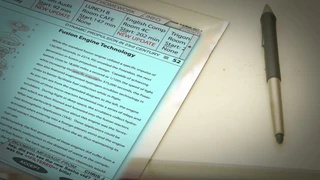<translate> When RSI announced the next generation of fusion engine, new and exciting prospects for space travel opened up, but not everyone was so enthused: </translate>

<translate> Bailey couldn’t believe it. Twenty minutes into Physics class and his Sheet was now getting a new download. Some new Engine Tech or something that came out today. He’d caught a glimpse of it on the way out the door this morning but these crappy public school Sheets were just getting the TextbookUpdate pings now.
Mr. Caro already said that we were gonna be quizzed on it and its updating now?! There’s no way. Just no way. This is so stupid. How the hell am I supposed to learn this now?
Screw it. I’ll bomb it. Screw this class. Screw Citizenship. Screw this whole system. I don’t need it…
Mr. Caro said the quiz would start in ten minutes. Bailey sunk into his seat and started studying.
Transcribed News Article
</translate>
<translate> "While the standard fusion engine utilized a specific impulse of 130,000 seconds, in 2214, RSI unveiled the Poseidon, the next generation in fusion propulsion design. Capable of achieving speeds close to 18,600 miles per second, or 1/10th the speed of light while increasing the specific impulse to 375,000 seconds, the Poseidon also feature augmented hydrogen-scrubber technology in order to better facilitate fuel collection while in flight.
As you can see from the exploded diagram on the left, the engine consists of three micro-reactors hardwired into a series of relays and scrubbers. During flight in deep space, the scrubbers collect hydrogen which are [sic] then filtered and funneled into the fusion reactors. What was particularly ingenious about this engine was the Terrestrial Atmospheric Applicators (TAA). These applicators could be activated when entering into a foreign planets atmo and the engine could extract necessary elements from the air, thus maintaining its fuel rate.
Unfortunately, the first generation of these engines did suffer from a recurring parts malfunction in the disposal of waste at the comple- [...] of fuel fusion. The back-up of potential toxic chemicals would... " </translate>
<languages/>
